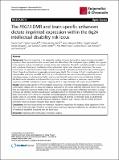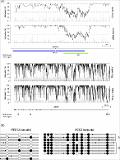Por favor, use este identificador para citar o enlazar a este item:
http://hdl.handle.net/10261/95686COMPARTIR / EXPORTAR:
 SHARE SHARE
 CORE
BASE CORE
BASE
|
|
| Visualizar otros formatos: MARC | Dublin Core | RDF | ORE | MODS | METS | DIDL | DATACITE | |

| Título: | The PEG13-DMR and brain-specific enhancers dictate imprinted expression within the 8q24 intellectual disability risk locus |
Autor: | Court, Franck; Camprubí, Cristina; Vicente García, Cristina; Guillaumet-Adkins, Amy; Sparago, Angela; Seruggia, Davide; Sandoval, Juan; Esteller, Manel; Martín-Trujillo, Alex; Riccio, Andrea; Montoliu, Lluís CSIC ORCID ; Monk, David | Palabras clave: | Imprinting DNA methylation Chromatin looping |
Fecha de publicación: | 25-mar-2014 | Editor: | BioMed Central | Citación: | Epigenetics & Chromatin 7(1): 5 (2014) | Resumen: | [Background]
Genomic imprinting is the epigenetic marking of genes that results in parent-of-origin monoallelic expression. Most imprinted domains are associated with differentially DNA methylated regions (DMRs) that originate in the gametes, and are maintained in somatic tissues after fertilization. This allelic methylation profile is associated with a plethora of histone tail modifications that orchestrates higher order chromatin interactions. The mouse chromosome 15 imprinted cluster contains multiple brain-specific maternally expressed transcripts including Ago2, Chrac1, Trappc9 and Kcnk9 and a paternally expressed gene, Peg13. The promoter of Peg13 is methylated on the maternal allele and is the sole DMR within the locus. To determine the extent of imprinting within the human orthologous region on chromosome 8q24, a region associated with autosomal recessive intellectual disability, Birk-Barel mental retardation and dysmorphism syndrome, we have undertaken a systematic analysis of allelic expression and DNA methylation of genes mapping within an approximately 2 Mb region around TRAPPC9. [Results] Utilizing allele-specific RT-PCR, bisulphite sequencing, chromatin immunoprecipitation and chromosome conformation capture (3C) we show the reciprocal expression of the novel, paternally expressed, PEG13 non-coding RNA and maternally expressed KCNK9 genes in brain, and the biallelic expression of flanking transcripts in a range of tissues. We identify a tandem-repeat region overlapping the PEG13 transcript that is methylated on the maternal allele, which binds CTCF-cohesin in chromatin immunoprecipitation experiments and possesses enhancer-blocker activity. Using 3C, we identify mutually exclusive approximately 58 and 500 kb chromatin loops in adult frontal cortex between a novel brain-specific enhancer, marked by H3K4me1 and H3K27ac, with the KCNK9 and PEG13 promoters which we propose regulates brain-specific expression. [Conclusions] We have characterised the molecular mechanism responsible for reciprocal allelic expression of the PEG13 and KCNK9 transcripts. Therefore, our observations may have important implications for identifying the cause of intellectual disabilities associated with the 8q24 locus. |
Versión del editor: | http://dx.doi.org/10.1186/1756-8935-7-5 | URI: | http://hdl.handle.net/10261/95686 | DOI: | 10.1186/1756-8935-7-5 | ISSN: | 1756-8935 |
| Aparece en las colecciones: | (CNB) Artículos |
Ficheros en este ítem:
| Fichero | Descripción | Tamaño | Formato | |
|---|---|---|---|---|
| 1756-8935-7-5.xml | 79,98 kB | XML | Visualizar/Abrir | |
| 1756-8935-7-5-S3.TIFF | 1,04 MB | TIFF |  Visualizar/Abrir | |
| 1756-8935-7-5.pdf | 1,96 MB | Adobe PDF |  Visualizar/Abrir | |
| 1756-8935-7-5-S5.DOCX | 136,52 kB | Microsoft Word XML | Visualizar/Abrir | |
| 1756-8935-7-5-S2.DOCX | 14,58 kB | Microsoft Word XML | Visualizar/Abrir | |
| 1756-8935-7-5-S4.TIFF | 969,56 kB | TIFF |  Visualizar/Abrir | |
| 1756-8935-7-5-S1.TIFF | 1,9 MB | TIFF |  Visualizar/Abrir |
CORE Recommender
PubMed Central
Citations
26
checked on 30-abr-2024
SCOPUSTM
Citations
42
checked on 06-may-2024
WEB OF SCIENCETM
Citations
36
checked on 26-feb-2024
Page view(s)
436
checked on 06-may-2024
Download(s)
840
checked on 06-may-2024

